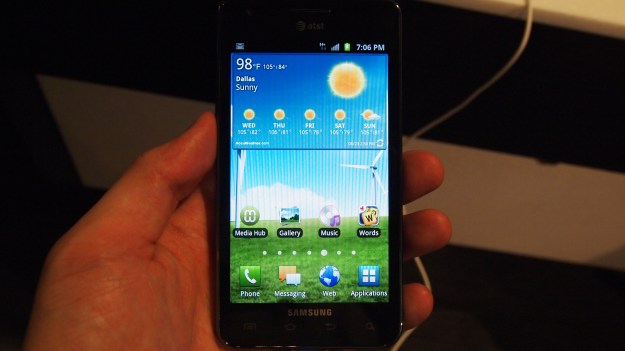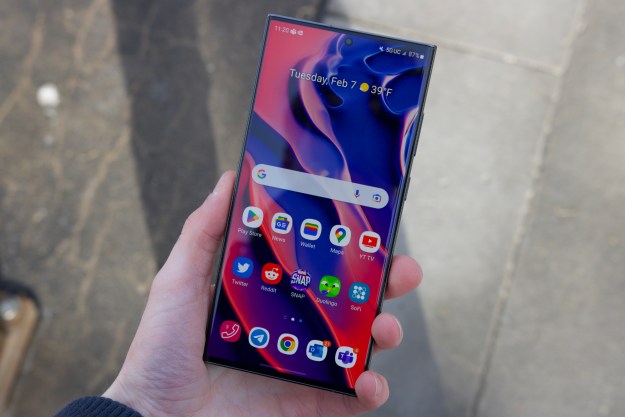
Yesterday, Samsung unveiled three new models of its flagship Galaxy S II phone, each variant destined for a different carrier (Sprint, AT&T, T-Mobile). We were on hand and took the time to try out both the AT&T and Sprint versions of the S II, which are, oddly, different from one another in a few ways. Samsung is clearly trying to build a universal brand with its Galaxy S phones, but it looks like each wireless carrier made a few of its own design tweaks to the phone. The Sprint model, for example, has a 4.5-inch screen, while the AT&T model is closer to resembling the 4.3-inch original Galaxy S II we’ve been seeing at trade shows all year. T-Mobile is withholding information on its own version, but from behind the plastic we noticed that it has more rounded corners and a brushed plastic back instead of a textured back like every other version. All three versions run Android Gingerbread, which is nice considering “Ice Cream Sandwich” is about to come out.
Less iPhone, more Android
The first thing we noticed about all of these models is that Samsung appears to be finally ending its love affair with the iPhone. Apple is currently suing the Korean manufacturer for blatantly trying to trick customers into thinking its phones were iPhones and we have to say, Apple actually had a point here. With these models, Samsung has gotten rid of the iPhone-like square app icons and abandoned its big Home button, a staple of the S II world phone.

The new version of TouchWiz that ships with all three of these phones also brings some notable innovations to the world of Android–we aren’t used to Samsung impressing us with software. Most impressive are the new types of motion gestures. Now, to do certain tasks, like zooming in on a webpage, you can hold your fingers on the page and tilt the phone up and down, which zooms in and out. Likewise, if you hold an icon or widget on your homepage and move your phone around, you can move it to other desktop pages. On the floor, these innovations were rather cool and exciting, but we’re not yet convinced they have actual staying power. I mean, do you really want to flail your phone around to zoom? We’ll see in time.

Samsung’s Social and Media hubs have also gotten small revamps. Both look somewhat useful, but not nearly as good as the Social hubs in Windows Phone devices.
Business folk, you’ll be happy to know that the Galaxy S II(s) also have on-device encryption of user data, Exchange ActiveSync support, Cisco VPN, Sybase MDM, and Cisco WebEx mobile conferencing. Or maybe you won’t. If anybody is a system administrator, do these features make the Galaxy S II more attractive?
Look and feel

Overall, we’re still quite impressed with how thin and lightweight the Galaxy S II is. It’s almost too light–it doesn’t feel heavy enough to do as much as it does. But hey, I think we’d get over that problem pretty quickly. Samsung’s 4.5-inch Super AMOLED screens are still industry leading, though we wish the resolution would bump up from 800×480 to 960×540, which is the new standard. Likewise, the phone was snappy thanks to the custom Samsung Exynos 1.2GHz dual-core processor, which Samsung took every opportunity to brag about. From what we experienced, it may be industry-leading, just as representatives frequently claimed.
Overall, the Galaxy S II won’t be the most powerful handset for long (if it is now), but it will be a great option for those buying a smartphone this autumn. It’s good to see Samsung catching up with HTC with its TouchWiz interface and we applaud their attempt to create a singular brand across all carriers. Hopefully Verizon will get on board so we can try out that 4G LTE Galaxy S II we’ve been reading about.
For more pictures of the event, check out our gallery.
Editors' Recommendations
- This Samsung tablet with S Pen stylus just had its price slashed to $199
- Best Samsung Galaxy deals: S24, Buds, Watches and more
- A new version of the Samsung Galaxy S24 could be coming soon
- 5 things I want to see in the Samsung Galaxy S25 Ultra
- Can this cheap Samsung phone beat the Galaxy S24? We found out


